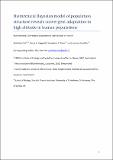Files in this item
Widespread signals of convergent adaptation to high altitude in Asia and America
Item metadata
| dc.contributor.author | Foll, Matthieu | |
| dc.contributor.author | Gaggiotti, Oscar E | |
| dc.contributor.author | Daub, Josephine T | |
| dc.contributor.author | Vatsiou, Alexandra | |
| dc.contributor.author | Excoffier, Laurent | |
| dc.date.accessioned | 2014-11-24T15:31:09Z | |
| dc.date.available | 2014-11-24T15:31:09Z | |
| dc.date.issued | 2014-10-02 | |
| dc.identifier | 154869403 | |
| dc.identifier | 2835bbc4-1417-42ac-b215-100b9689b2c8 | |
| dc.identifier | 25262650 | |
| dc.identifier | 84921786534 | |
| dc.identifier | 000342654300005 | |
| dc.identifier.citation | Foll , M , Gaggiotti , O E , Daub , J T , Vatsiou , A & Excoffier , L 2014 , ' Widespread signals of convergent adaptation to high altitude in Asia and America ' , American Journal of Human Genetics , vol. 95 , no. 4 , pp. 394-407 . https://doi.org/10.1016/j.ajhg.2014.09.002 | en |
| dc.identifier.issn | 0002-9297 | |
| dc.identifier.other | ORCID: /0000-0003-1827-1493/work/61370085 | |
| dc.identifier.uri | https://hdl.handle.net/10023/5833 | |
| dc.description | This work has been made possible by Swiss National Science Foundation grants No. 3100A0-126074, 31003A-143393, and CRSII3_141940 to L.E. O.E.G. was supported by French ANR grant No 09-GENM-017-001 and by the Marine Alliance for Science and Technology for Scotland (MASTS). | en |
| dc.description.abstract | Living at high altitude is one of the most difficult challenges that humans had to cope with during their evolution. Whereas several genomic studies have revealed some of the genetic bases of adaptations in Tibetan, Andean, and Ethiopian populations, relatively little evidence of convergent evolution to altitude in different continents has accumulated. This lack of evidence can be due to truly different evolutionary responses, but it can also be due to the low power of former studies that have mainly focused on populations from a single geographical region or performed separate analyses on multiple pairs of populations to avoid problems linked to shared histories between some populations. We introduce here a hierarchical Bayesian method to detect local adaptation that can deal with complex demographic histories. Our method can identify selection occurring at different scales, as well as convergent adaptation in different regions. We apply our approach to the analysis of a large SNP data set from low- and high-altitude human populations from America and Asia. The simultaneous analysis of these two geographic areas allows us to identify several candidate genome regions for altitudinal selection, and we show that convergent evolution among continents has been quite common. In addition to identifying several genes and biological processes involved in high-altitude adaptation, we identify two specific biological pathways that could have evolved in both continents to counter toxic effects induced by hypoxia. | |
| dc.format.extent | 14 | |
| dc.format.extent | 6648978 | |
| dc.language.iso | eng | |
| dc.relation.ispartof | American Journal of Human Genetics | en |
| dc.subject | QH301 Biology | en |
| dc.subject | BDC | en |
| dc.subject | R2C | en |
| dc.subject.lcc | QH301 | en |
| dc.title | Widespread signals of convergent adaptation to high altitude in Asia and America | en |
| dc.type | Journal article | en |
| dc.contributor.institution | University of St Andrews. School of Biology | en |
| dc.contributor.institution | University of St Andrews. Marine Alliance for Science & Technology Scotland | en |
| dc.contributor.institution | University of St Andrews. Scottish Oceans Institute | en |
| dc.identifier.doi | 10.1016/j.ajhg.2014.09.002 | |
| dc.description.status | Peer reviewed | en |
This item appears in the following Collection(s)
Items in the St Andrews Research Repository are protected by copyright, with all rights reserved, unless otherwise indicated.

